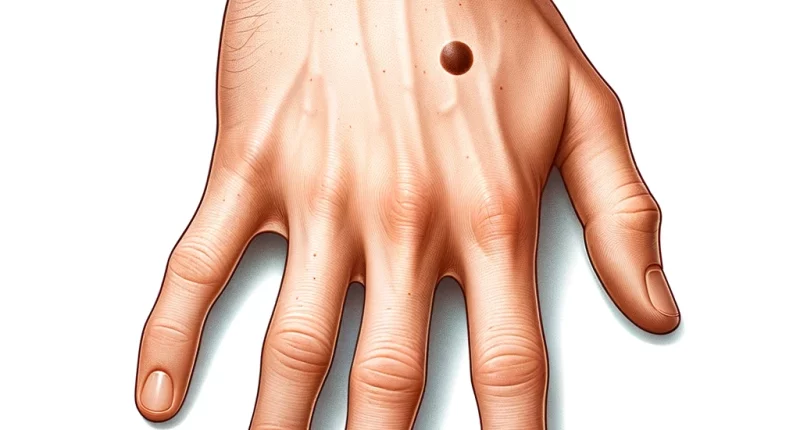Melanoma
What is melanoma?
Melanoma is a dangerous cancer manifested by the growth of a malignant tumor in the skin or mucous membranes. Oncodermatologists carry out the diagnosis and treatment of this pathology.
Melanoma is a malignant neoplasm formed from skin pigment cells and mucous membranes. The cause of the disease is abnormal degeneration and active division of melanocytes. Usually, the tumor is formed on the surface of the skin, but it is possible to develop melanoma in the oral cavity, intestine, vagina, and retina. External influences and hereditary factors can cause the appearance of pathology.
Melanoma is considered the most aggressive type of skin oncology: the tumor grows rapidly and rapidly metastasizes to distant organs. In the first stages, there is often only horizontal growth of the neoplasm, but the pathological focus begins to spread to deep tissues as it develops. The appearance of secondary tumors in the lungs, brain, liver, and other organs significantly worsens the prognosis, so it is essential to conduct timely surgical and therapeutic treatment.
Symptoms of melanoma
Most often, melanoma is formed from the cells of a birthmark, so it is necessary to monitor the external condition of the skin. Pain and other symptoms related to well-being are usually absent in the early stages. The precancerous condition can not always be distinguished from a harmless mole without a particular examination, so it is recommended to consult a dermatologist for any suspicious skin changes.
Possible signs of a malignant mole:
- Asymmetrical shape and uneven edges;
- Small hemorrhages;
- Rapid horizontal growth;
- Appearance of visible thickenings (nodules) on the surface;
- Uneven coloration: different areas of melanoma may be black, dark brown, or gray;
- Redness of the skin around the mole;
- Absence of skin pattern on the surface.
Melanoma only sometimes has the signs listed above. Several types of malignant tumors differ in shape, kind of growth, and size. Some melanomas are formed under the nails, in the eye area, and in other hidden places, so skin examination does not always allow you to detect signs of oncology. Metastasis of the neoplasm at late stages leads to additional symptoms.
Causes of melanoma
The cellular composition of the skin and mucous membranes is constantly renewed in the human body: old surface layer cells gradually die off, after which new melanocytes are formed. Damage to the cell’s genetic information can cause malignant tissue degeneration and tumor growth. The exact causes of this anomaly are unknown, but research has helped scientists identify risk factors for developing skin neoplasms.
Factors that contribute to melanoma formation:
- Pale skin. Lack of pigment in skin cells causes less reliable protection of tissues from ultraviolet radiation;
- Unfavorable family history. The risk of melanoma formation increases if at least one relative of the patient has been diagnosed with this disease;
- Excessive exposure of the skin to sunlight: ultraviolet radiation can negatively affect melanocytes;
- A large number of birthmarks on the surface of the skin (more than 50);
- Formation of abnormal (dysplastic) moles characterized by altered cellular structure;
- Weakened immune system.
The listed risk factors are not direct causes of melanoma formation, but the combination of several types of predisposition to the disease can provoke the manifestation of cancer heredity.
Diagnosis of melanoma
There are several highly accurate methods to diagnose cancer. During the initial appointment, the oncodermatologist asks the patient about complaints and examines anamnestic data. After that, the doctor examines the suspicious formation and decides whether to prescribe additional examinations. Studying the skin’s structure and excluding any changes indicatingmalignant tissue growth is necessary.
Methods of diagnosis of melanoma:
- Dermatoscopy is a visual examination of the skin and mucous membranes involving multiple magnifications of the image using optical or digital methods. The doctor brings the dermatoscope close to the skin mass and studies the tissue structure through the eyepiece. The oncodermatologist also examines neighboring skin areas and lymph nodes to detect metastases;
- Visual examinations of internal organs to look for secondary neoplasms. The oncodermatologist prescribes the patient an X-ray, computerized tomography, or magnetic resonance imaging. The resulting images allow the doctor to exclude the lesion of other organs and determine the stage of oncology;
- Histologic analysis. The surgeon removes the mole and a small amount of nearby healthy tissue and sends the obtained material to the laboratory to clarify the diagnosis. Individual cells are not taken by puncture (biopsy) because of the risk of tumor metastasis;
- A swab sample of the mole. The specialist sends the obtained material to our laboratory for cytological analysis. The patient is prescribed additional examinations if altered melanocytes are detected in the smear.
Our clinic uses modern diagnostic equipment, allowing the oncodermatologist to detect the cancer process in its early stages.
Surgical treatment of melanoma
After confirming the diagnosis and determining the stage of the cancer process, the oncodermatologist prescribes surgical intervention to remove the primary tumor. It is necessary to excise the malignant tissue and nearby skin structures to prevent the development of recurrence.
Operativeoptions
- Wide excision of a malignant skin neoplasm. The surgeon anesthetizes the tissue with local anesthesia and performs antiseptic treatment of the skin. The volume of tissue removed depends on the depth of tumor spread. If necessary, the surgeon also removes nearby lymph nodes that may contain abnormal melanocytes;
- Layer-by-layer excision of a malignant tumor (Mohs operation). After the initial excision of the visible tumor, the specialist successively removes thin layers of skin and immediately examines the resulting slices with a microscope. The map of the location of the melanoma remnants in the deep layers of the skin is used to complete the intervention.
The advantage of this treatment is less traumatic tissue trauma and preservation of the appearance of the skin area. Our clinic has its surgical department where the most complex operations are performed.
Conservative treatment of melanoma
Additional ways of treating the disease depend on the extent of melanoma. Therapeutic treatment is prescribed if the oncodermatologist detects deep skin lesions or the formation of several tumors.
- Immunochemotherapy is a drug treatment that involves administering chemotherapy and immunotherapy at the same time. The doctor administers medications intravenously or prescribes oral medicines to the patient. The main components of therapy are cytostatic and cytotoxic substances that stop the growth of malignant tissue and destroy individual tumor cells. Interferons, interleukins, and other immunostimulants increase the effectiveness of chemotherapy;
- Radiation therapy is the destruction of tumor cells using ionizing radiation. A radiologist uses special equipment to spot-irradiate the affected tissue. This method of treatment is usually prescribed when melanoma metastases are detected;
- Targeted therapy is a modern method of drug treatment in oncology. The doctor prescribes drugs that affect certain molecular regions of tumor cells, as a result of which further growth of melanoma and its metastases is blocked.
All these treatment options are performed in more than 800 hospitals worldwide (https://doctor.global/results/diseases/melanoma). For example, Mohs surgery is done in 31 clinics across Germany for an approximate price of $5,142 (https://doctor.global/results/europe/germany/all-cities/all-specializations/procedures/mohs-surgery).
Melanoma prevention
Following a few recommendations can significantly reduce the risk of melanoma. Prevention of this disease is primarily necessary for people who have a predisposition to the development of malignant skin tumors.
KeyRecommendations:
- Avoiding prolonged exposure of exposed skin to sunlight;
- Avoidance of any tanning methods;
- Using a cream that reduces the effects of ultraviolet radiation on the skin;
- Regular checkups with a dermatologist if you have a large number of birthmarks;
- Removal of protruding and abnormal moles.
Conclusion
Melanoma, a serious form of skin cancer, arises from the pigment-producing cells known as melanocytes. While it’s less common than other skin cancers, melanoma is more likely to grow and spread if not treated early. The key to successfully managing and treating melanoma lies in early detection and prompt intervention. Awareness of risk factors, such asexcessive sun exposure and a history of sunburns, is crucial. Regular skin examinations and consulting a healthcare professional when changes in skin appearance are noticed can be life-saving. Advances in medical treatments, including surgery, immunotherapy, and targeted therapies, have significantly improved outcomes for melanoma patients. However, prevention and early detection remain vital, as they significantly increase the likelihood of successful treatment and reduce the risk of severe complications.


